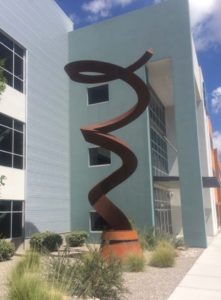By Finance New Mexico
Public art has been a force for economic development in New Mexico at least since the Great Depression, when the federal government paid hundreds of unemployed artists to create murals, sculpture and other artworks that grace federal buildings to this day.
Nearly a century later, many New Mexico cities are using public art projects to promote economic vitality by creating a foundation for community identity, centralizing disparate neighborhoods with a collective vision and attracting the attention of businesses that value culturally vibrant communities. One of those cities is Rio Rancho.
“Public art speaks to our culture and how we value the places we live in,” said Daniel Chamberlain, an architect with FBT Architects and chairman of Rio Rancho’s volunteer Arts Commission. “It is a wonderful negotiator of vision. It’s a quality-of-life driver.”
The payback can be enormous, Chamberlain said, even if it’s hard to measure.
Committed to the Arts
Rio Rancho created its Arts Commission in 2009 in response to recommendations by the city’s quality of life task force and as a way to infuse the city’s master plan with financial support for public art projects. The city underscored that commitment by agreeing to set aside 1 percent of the revenues raised through related bond issues to cover the cost of public art projects.
While public art isn’t a major job creator and its merits can’t be evaluated with traditional performance metrics, advocates argue that it contributes to economic development in multiple ways: It highlights a community’s cultural assets, builds community pride, draws people together from inside and outside the city and enhances the natural and urban landscape.
For example, the city in 2012 integrated art into the construction of a flood wall that was built for erosion control along Unser Boulevard, Rio Rancho’s main corridor from Interstate 25. To spruce up the otherwise dull and utilitarian structure, three 11-foot-tall monuments were built and embellished with colorful, weather-resistant murals featuring the area’s plants and animals.
Arts Commission members see public art being integrated into many aspects of the city’s urban planning, including signage and landscape development codes. An example of the latter is the commission’s proposal to substitute works of art for drought-killed trees on arterial medians.
Building Connectedness
Chamberlain identified three components of Rio Rancho’s 2016 public arts plan: agreeing on universal and binding themes, obtaining funding and identifying where to place works of art to have the greatest impact on residents’ quality of life.
The commission came up with four themes that emphasize members’ desire to work with what nature provides — earth, wind, sky and sun; light and darkness; shade and shadow; and natural landscape and habitat. Commission members proposed to supplement the 1 percent set-aside with grant money and private donations.
And the commission is committed to distributing artworks in each of the city’s six districts and thinking creatively of how natural features like arroyos and trails that wend through different neighborhoods can be transformed by art into cultural corridors that bridge geographical boundaries.
Public art is central to the city’s efforts to connect the city’s neighborhoods, Chamberlain said, and to build a more inclusive sense of community.
For more information about the New Mexico Art in Public Places Act, visit www.nmarts.org/art-in-public-places/.
Download 474_Public-Art-Is-Tool-for-Economic-Community-Development PDF

